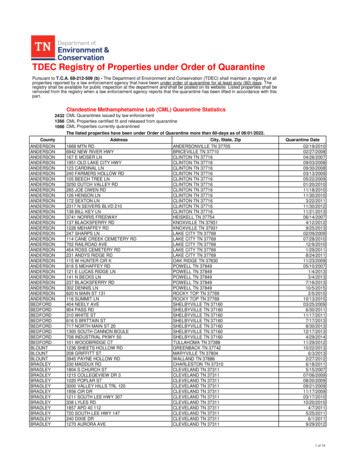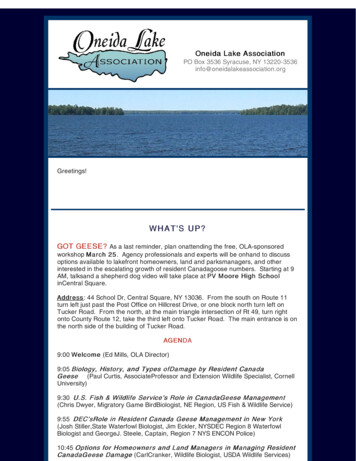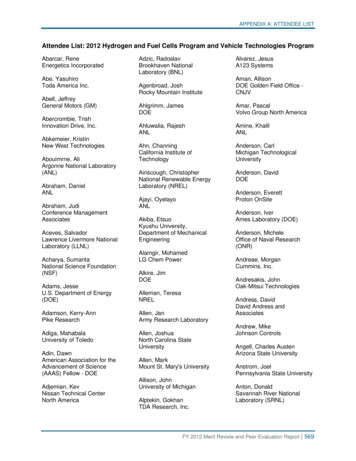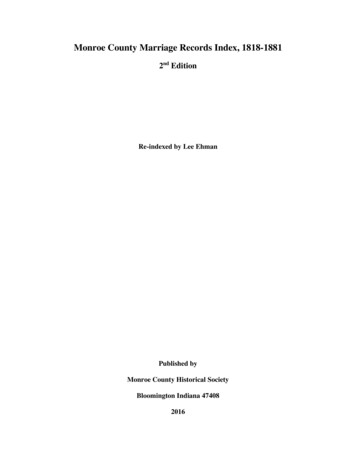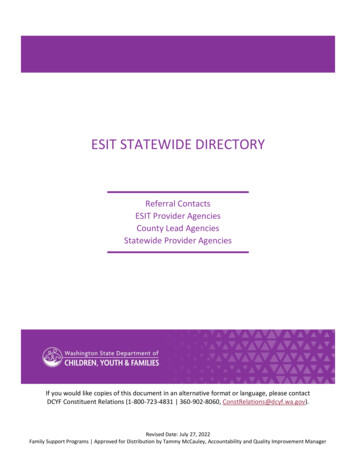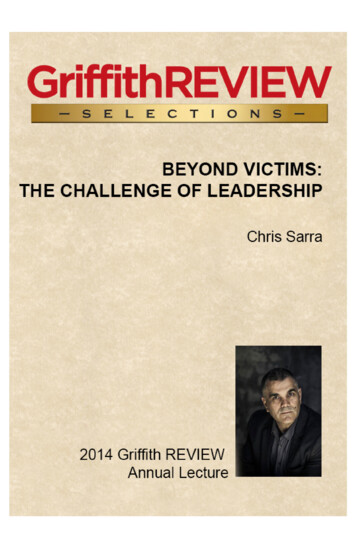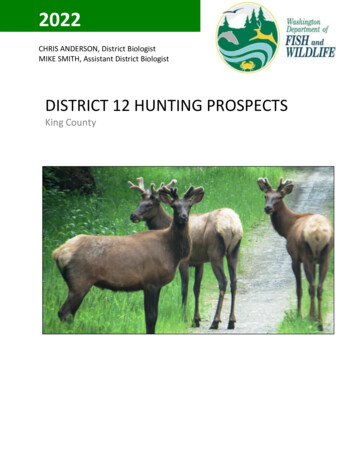
Transcription
2022CHRIS ANDERSON, District BiologistMIKE SMITH, Assistant District BiologistDISTRICT 12 HUNTING PROSPECTSKing County
TABLE OF CONTENTSDISTRICT 12 GENERAL OVERVIEW . 1ELK . 2Elk Hoof Disease (Treponeme bacteria). 4DEER . 6ADENOVIRUS HEMORRHAGIC DISEASE . 9BEAR . 10COUGAR . 11PHEASANT . 12QUAIL . 12FOREST GROUSE . 13EURASIAN COLLARED DOVE . 14TURKEY . 14WATERFOWL . 14ADDITIONAL INFORMATION . 15FIREARMS RESTRICTION AREAS IN KING COUNTY . 15
DISTRICT 12 GENERAL OVERVIEWDistrict 12 is comprised of six game management units (GMUs), including 422 (Vashon/MauryIslands), 454 (Issaquah), 460 (Snoqualmie), 466 (Stampede), 485 (Green River, open toappropriate deer and elk permit holders only), and 490 (Cedar River, currently closed to statehunters). Land ownership in the district is a checkerboard of private, state, and federalproperties. The densest private (urban and suburban) developments are found in the IssaquahUnit (GMU 454), while private agricultural properties are primarily located in the northwesternpart of the Snoqualmie Unit (GMU 460).A great tool for determining property ownership and boundaries can be found using KingCounty iMap. We also suggest the WDFW Hunt Planner webmap.Tacoma and Seattle each own and operate municipal watersheds in southeast King County,totaling about 250,532 acres that supply drinking water for their cities. One is in the GreenRiver drainage (GMU 485), one is in the Tolt River drainage (a portion of GMU 460), and theother is in the Cedar River drainage (GMU 490).The largest huntable area is U.S. Forest Service (USFS) land, but industrial timber companiesalso have large properties in the area. Private, state, and federally owned lands are managedprimarily to produce timber. USFS lands are managed for multiple uses, including timber,recreation, and wildlife, with a current emphasis on growing and managing old-growth forests.Lands across District 12 are especially popular for a variety of year-round recreation activities.Always respect safety corridors and No Shooting Areas. Remember to be a good hunting andoutdoor steward. Be courteous and respectful of others to support quality experiences foreveryone. Hunt in a manner that seeks to avoid negative interactions with other userswhenever possible, such as avoiding busy trails and hunting during early morning hours.Please pick up after yourself and don’t leave a gut pile out in the open – cover, bury, or hike itout and dispose of it properly. For the benefit of all fish and wildlife, strongly considerutilizing copper or non-toxic ammunition even in locations and for game species where it isnot required. Similarly, shotgun shells with biodegradable wads are becoming more availableand are less harmful to the environment.For hunters interested in using e-bikes, note that they are typically considered motorizedvehicles allowed only on roads and trails open to other motorized use (local regulations mayvary), Hunters should check with each landowner, public or private, to ensure they are allowed.Please see the WDFW and DNR E-bike policy planning webpages for more information.Visitors to WDFW- and DNR-managed lands with a parking placard for people with disabilitiescan use Class 1 and Class 2 e-bikes on all non-motorized natural surface trails and closed roadswhere bicycles are allowed until June 30, 2023, or until new legislation is enacted.1 P a g e
ELKHunters should place greater emphasis on riparian forest habitats and agricultural areasthroughout the district, as well as public lands adjacent to such areas. Many of District 12 elkreside on private land, so make sure you have permission before you hunt.Game Management Unit (GMU) 460 (Snoqualmie) provides good hunting opportunities in areasof the unit. Hunters are advised to scout their preferred hunting areas well in advance becausestate and private timberlands are gated with restricted access. Many elk in the GMU are found(at least at times) on private property in valley bottoms (refer to Elk Area 4601 below), and elkdensity is much lower in the mountainous eastern portion of the unit. Hunters should networkwell in advance to gain access to hunt private properties. Please be mindful of residences,domestic animals (pets/livestock), and other non-target objects downrange when hunting theseareas. Hunters should plan for safe shooting lanes. A map of King County no shooting areas isavailable online and a description of firearm restriction areas can be found on page 90 of thehunting regulations pamphlet.Elk Area 4601 is almost entirely comprised of private property and may hold half the elk in theSnoqualmie unit. Elk Area 4601 was formed in 2009 and antlerless opportunity was addedduring permit seasons to help reduce the elk population in and around North Bend andSnoqualmie. Since 2014, general season archery and muzzleloader hunts in Elk Area 4601 haveincluded opportunity for antlerless harvest as well. Antlerless opportunity was added tomodern firearm in 2021 to allow property owners (and those with permission) to harvestwithout the need for special permits. In the interest of safety in this area, hunters are stronglyencouraged to consider using muzzleloader or archery equipment during the modern firearmseason.Elk in GMU 454 (Issaquah) continue to be managed with liberal seasons designed to reducevehicle/elk collisions and keep damage issues at acceptable levels in highly developed areas.Much of this unit is in private property. Pre-season planning and networking may be mostimportant for hunters trying to gain access in this unit. Hunters should also be mindful of safetyconcerns and firearm restrictions in this unit. Bowhunters should have an advantage in gainingpermission.GMU 466 (Stampede) is a mix of private, state, and USFS lands (Mount Baker-SnoqualmieNational Forest). There are some old-growth stands on USFS lands, with second-growth timberdominating much of the unit. While elk are often present here at higher densities than othermountainous areas in District 12—providing the chance for exceptional experiences—huntersshould be prepared for up to a 2,500-feet elevation change and steep terrain in this unit.Though many forest roads exist, road conditions and access vary considerably. Early snowfall inthe unit has the potential to strand hunters, but also the potential to aid in success.2 P a g e
GMU 485 (Green River) follows the posted boundary of the controlled-access portion of theTacoma Water Green River Watershed. Tacoma Water limits public access to protect the watersupply. Elk are managed with special permit hunts. During the 2022 season, 10 any bull, 10antlerless and two youth antlerless elk tags are available for hunters through the draw system.Figure 1. Bull elk in GMU 460 – Photo by Mike SmithFigure 2. Group of elk in GMU 460 – Photo by Mike SmithAnnual harvest reports and harvest statistics based on hunter reporting can be found online onWDFW’s Elk Harvest Reports webpage.3 P a g e
Elk Hoof Disease (Treponeme bacteria)Since 2008, reports of elk with deformed, broken, or missing hooves have increaseddramatically in southwest Washington, with sporadic observations in other areas west of theCascade Range, including within the North Rainier elk herd range. While elk are susceptible tomany conditions which result in limping or hoof deformities, the prevalence and severity of thisnew affliction suggested something altogether different. WDFW diagnostic research (2009–2014), in conjunction with a panel of scientific advisors, found that these hoof abnormalitieswere strongly associated with treponeme bacteria, known to cause a hoof disease of cattle,sheep, and goats called digital dermatitis. Although digital dermatitis has affected the livestockindustry for decades, Treponeme-Associated Hoof Disease (TAHD) is the first known instance ofdigital dermatitis in a wild ungulate. The disease is currently concentrated in southwesternWashington where prevalence is highest in Cowlitz and Wahkiakum counties, and westernLewis County. The disease is also present at lower prevalence in elk herds that are distant anddiscrete from the core affected area, including the North Rainier elk herd area.All of District 12 is within the North Rainier elk herd range. WDFW has received sporadic reportsof limping elk throughout District 12 for several years. However, the presence of TAHD has onlybeen confirmed within District 12 from elk sampled in GMUs 454 and 485.While many questions remain about the disease, several aspects of TAHD in elk are clear: Vulnerability: The disease appears to be highly infectious among elk, but there is noevidence that it affects humans. TAHD can affect any hoof in any elk, young or old, maleor female. Hooves only: Tests show the disease is limited to animals’ hooves and does not affecttheir meat or organs. If the meat looks normal and if hunters harvest, process, and cookit practicing good hygiene, it is probably safe to eat. No treatment: There is no vaccine to prevent the disease, nor are there any provenoptions for treating it in the field. Similar diseases in livestock are treated by cleaningand bandaging their hooves and giving them foot baths, but that is not a realistic optionfor free-ranging elk.4 P a g e
How hunters can help:WDFW is implementing an incentive-based pilot program to encourage west-side (400, 500,600 series GMUs) hunters to harvest elk with hoof disease (TAHD), thereby potentially reducingprevalence of the disease over time. The program has two complimentary but independentcomponents: WDFW is offering an incentive permit opportunity to hunters that harvest a diseased elkduringgeneral or special permit seasons. Hunters can participate in the program by submitting thehooves from their elk harvest at one of many drop-off locations. Hunters that submit hooveswith signs of TAHD (i.e., abnormal hooves) will be automatically entered into a drawing for aspecial incentive permit. The incentive special permits will include multiple bull permits inwestern Washington. The season dates will be Sep. 1-Dec. 31 and the incentive permit drawwill be held prior to the special permit application deadline. All participating hunters willreceive a custom, waterproof license holder. Additionally, WDFW is offering special permits under the Master Hunter permit category thatare intended to target diseased elk. These permits are offered as a second elk opportunityfor antlerless elk using any weapon type (except during overlapping general seasons wherethey are restricted to the general season weapon type) and are not restricted to private land.Under this permit, Master Hunters must submit all four hooves from their harvest to WDFWfor inspection. Elk harvested by Master Hunters under this permit cannot be submittedthrough the incentive program described above because selection for this permit is itself anincentive.WDFW is working with scientists, veterinarians, outdoor organizations, tribal governments, andothers to better understand and manage TAHD. For more information about TAHD, visitWDFW’s webpage. Additional information on TAHD and this incentive program can also befound on page 65 of the Big Game Hunting Pamphlet or on the WDFW webpage.5 P a g e
DEERWashington Department of Fish and Wildlife (WDFW) has not conducted black-tailed deerpopulation surveys for several years throughout District 12 due to funding and staffinglimitations. However, anecdotal observations and annual harvest statistics indicate huntingprospects can be quite good where hunting is allowed on private and public lands.Game Management Unit (GMU) 422 covers all of Vashon and Maury islands. Hunting access onVashon and Maury islands is mostly on private agricultural and hobby farm properties. KingCounty’s Island Center Forest may open to public hunting pending county decision-making;please contact the county for details. Hunters must take time to network with communities andproperty owners for opportunity and access. More opportunities (incorporated in recent years)will continue in the second deer special permit category for GMU 422. Please refer to thecurrent Big Game pamphlet for updated listings of these opportunities.Washington Department of Fish and Wildlife continues to manage deer in Game ManagementUnit (GMU) 454 (Issaquah) with liberal seasons designed to prevent vehicle/deer collisions andkeep damage issues at acceptable levels in highly developed areas. More opportunities wererecently added in the second deer special permit category for GMU 454 with the addition ofDeer Area 4541 (North Issaquah). Please refer to the current Big Game pamphlet for updatedlistings of these opportunities. This unit (and corresponding deer area) is about 90% privateland and hunters continue to have a problem with access. Success in this unit may well dependon getting to know your neighbors and raising the subject of hunting as a means of protectingtheir fruit trees and vegetables. Firearm restrictions are in place because landowners areconcerned about safety. Bowhunters should have an advantage in getting permission.6 P a g e
Figure 3. A black-tailed deer buck in GMU 454, damaging landscape plantingsGame Management Unit 460 (Snoqualmie) has good hunting opportunities throughout most ofthe unit. However, hunters should scout their preferred hunting areas well in advance becausestate and private timberlands are gated with restricted access. Forest management on theselands is favorable to deer and high-quality opportunities are available. Hunters should focus onearly seral forests (less than 30 years old) next to mid (40-80 years old) or late-successional(greater than 80 years old) stands. Hunters should focus on riparian forest habitats that supplyample forage and cover. Backcountry hunting opportunities also exist in the eastern portion ofthe unit, including the High Buck Hunt within the Alpine Lakes Wilderness. Hunters here shouldbe mindful of very high recreational presence. By reviewing maps and scouting, quality alpineexperiences can still be found, especially in smaller basins not accessed by major trails.7 P a g e
Figure 4. A doe and fawns in King County – Photo by Mike SmithGame Management Unit 466 (Stampede) is a patchwork of private, state, and U.S. ForestService lands (Mount Baker-Snoqualmie National Forest). It consists of second-growth timber,with some old growth on U.S. Forest Service lands. This unit has a lot of steep ground, withabout 2,500 feet in elevation change. Though many forest roads exist, road conditions andaccess vary considerably. Be prepared for early winter snowfall, which has the potential ofstranding hunters, but also the potential to improve success.Game Management Unit 485 (Green River) follows the posted boundary of the controlledaccess area of the Tacoma Water Green River Watershed. Tacoma Water limits public access toprotect the water supply. Deer are managed with special permit hunts. During the 2022 season,five any buck tags in the Quality category and five any buck tags in the Hunters with Disabilitiescategory are available for state hunters through the draw system.Annual harvest reports and harvest statistics based on hunter reporting can be found onWDFW’s Deer Harvest Reports webpage.8 P a g e
Adenovirus Hemorrhagic DiseaseAdenovirus Hemorrhagic Disease (AHD) was detected on British Columbia’s Gulf Islands andVancouver Island during the fall of 2020. AHD was then found on Orcas and San Juan Islandsduring May and June 2021. The disease impacted deer on other islands in the San JuanArchipelago, including Blakely, Henry, Lopez, Shaw, and Stuart islands. In the fall of 2021,Washington Department of Fish and Wildlife confirmed AHD on Whidbey Island. However,Washington Department of Fish and Wildlife has NOT detected AHD in District 12 at this time.AHD is caused by a viral infection and is transmitted by direct contact between deer, eitherthrough bodily fluids or possibly airborne routes. This makes it more likely for the virus tospread in areas with high deer concentrations.AHD does not pose a risk to livestock, pets, or people – from contact or by consuming the meat.However, the use of disposable gloves is always recommended for handling any wildlifecarcass. To reduce the risk of spreading AHD to new areas, hunters should use discretion beforeharvesting deer in AHD-impacted areas to avoid harvesting AHD-infected deer. AHDsymptoms include rapid or open mouth breathing, foaming or drooling at the mouth, diarrhea(sometimes bloody), weakness, and emaciation. Should hunters in District 12 encounter live ordead deer with signs of AHD, please report them through the Department’s online reportingform. More information on AHD is available at WDFW’s Wildlife Diseases webpage.9 P a g e
BEARBlack bears inhabit areas of District 12, but like elk, many are on private lands. Hunters shouldensure they have permission to hunt where they’re interested. Berry production throughoutthe district may be affected by cooler temperatures and above average precipitationexperienced during the spring. Bears are often at lower elevations early on, including riparianareas, before they move higher as the season progresses, which can offer opportunities forhunters on public lands. Scouting to locate berry patches and recent bear sign, then returningto monitor these areas during cooler morning and evening hours when bears are more activecan be effective.Figure 5 . A bear in GMU 460 – WDFW photoHunters in District 12 harvested 45 bears during the fall season in 2021. Nine percent (n 20) ofhunters in GMU 454, 4% (n 14) in GMU 460 and 7 % (n 11) in GMU 466 reported harvesting abear. Annual harvest reports and harvest statistics can be found online at Bear Harvest Reports.10 P a g e
COUGARThe harvest guideline for GMU 460 is four to six cougars. For GMUs 466, 485, and 490 theguideline is two to three animals (GMU 485 is only open to deer or elk special permit holdersand GMU 490 is closed to state hunting). There is no guideline for GMU 454. The WashingtonDepartment of Fish and Wildlife Director may close the late cougar hunting season on or afterJan. 1 in either of these units if the cougar harvest meets or exceeds the guideline. Starting Jan.1, hunters may hunt cougar until the area harvest guideline is reached, or April 30, whicheveroccurs first. Each cougar hunter must verify if the cougar late hunting season is open or closedin areas with a harvest guideline. Cougar hunters can verify if the season is open or closed bycalling the toll-free cougar hunting hotline at 1-866-364-4868 or visiting WDFW’s website. Thehotline and website will be updated weekly beginning Jan. 1, 2022. Hunters must have a 202324 cougar license and tag to hunt cougar in April 2023.11 P a g e
PHEASANTWashington Department of Fish and Wildlife will release game farm pheasants this fall on theSnoqualmie Wildlife Area. Site maps are available in the Western Washington Pheasant ReleasePamphlet. Hunters must use the non-toxic shot on all pheasant release sites.Hunting hours for pheasant and quail in Western Washington are from 8 a.m. to 4 p.m. Thisincludes the Stillwater, Cherry Valley, and Crescent Lake units of the Snoqualmie Wildlife Area.For the rest of the hunting season, normal hunting hours (a half-hour before sunrise to halfhour after sunset) will apply.QUAILThere are few quail in District 12.12 P a g e
FOREST GROUSERuffed and sooty (blue) grouse are found throughout the public and private forests of District12. Forest management in much of District 12 is still favorable for grouse. Hunters looking toharvest ruffed grouse should focus on elevations below 2,500 feet, early seral forests (5-30years old) with ample berry crops in the understory, and riparian forest habitats. Sooty grousehunters can expect the greatest success along trails and ridgelines above 2,000 feet and withinPacific silver fir and noble fir forest stands with abundant huckleberries.Adult female and juvenile grouse are especially vulnerable during early September. Beginning in2021 grouse seasons have been adjusted to limit harvest of these individuals. More informationis available in this blog post. The season will be open Sep. 15, 2022, through Jan. 15, 2023.Washington Department of Fish and Wildlife (WDFW) collects wings and tails of hunterharvested forest grouse (spruce, ruffed, dusky and sooty species) during the hunting season.The goal of this collection effort is to build estimated population trend datasets for each speciesto evaluate harvest changes. Other factors will also be evaluated, including wildfire andweather patterns that may contribute to changes in harvest and overall populations at thespecies level.Grouse hunters can help by depositing one wing and the tail of each grouse harvested into wingcollection barrels placed around the state or by bringing them to the closest WDFW District orRegional office. Visit the WDFW forest grouse collection webpage for more information andcollection barrel locations.Figure 6. A male sooty grouse displaying on the Snoqualmie Tree Farm, GMU 460 – Photo by Chris Anderson13 P a g e
EURASIAN COLLARED DOVEAlthough not a managed game species, Eurasian collared doves (an exotic species) are now inDistrict 12. People can hunt Eurasian collared doves year-round with a big or small gamelicense. The best way to hunt them is to seek landowner permission in lowland agriculturalareas that have a barnyard setting where birds roost in trees but go to the ground to feed.Hunters should be sure they are hunting in compliance with any firearm restrictions and amanner compatible with existing infrastructure (buildings, farm equipment, or power lines).TURKEYWild turkeys are rare in District 12, without predictable concentrations of birds. Harvestprospects are low even with considerable effort. Hunters must use #4 shot or smaller to huntturkey.WATERFOWLFigure 7. Northern pintail in GMU 454 – Photo by Mike SmithHarvest opportunities should be good, dependent on weather conditions through the season.The best waterfowl hunting opportunities continue to be in the lower Snoqualmie Valley, withpublic access on WDFW’s Snoqualmie Wildlife Area (Cherry Valley, Stillwater, and Crescent Lakeunits). Hunters can only enter and hunt units between 8 a.m. and 4 p.m. during the pheasantseason. More opportunities are in the Kent Valley. Hunters are encouraged to work with localprivate landowners to get access to one of District 12’s many rivers and agricultural valleys andimprove their waterfowl hunting success. Refer to the Migratory Waterfowl & Upland GameRegulations for season dates and hours.For an excellent introduction to waterfowl hunting, visit the webpage, Let’s Go Waterfowlhunting.14 P a g e
ADDITIONAL INFORMATIONFirearms restriction areas in King CountyCenterfire and rimfire rifles are not legal for hunting west of Highway 203 (Monroe-Fall City),the Fall City-Preston Road to I-90, I-90 to Highway 18, Highway 18 to I-5, and I-5 to Pierce-KingCounty line. They are also not legal for hunting on Vashon and Maury islands. For moreinformation, refer to page 90 of the 2022 Big Game Hunting Regulations. There aren’t manyshooting areas in King County per county ordinances. Please contact your local sheriff forspecific locations.15 P a g e
A great tool for determining property ownership and boundaries can be found using King County iMap. We also suggest the WDFW Hunt Planner webmap. Tacoma and Seattle each own and operate municipal watersheds in southeast King County, totaling about 250,532 acres that supply drinking water for their cities.
